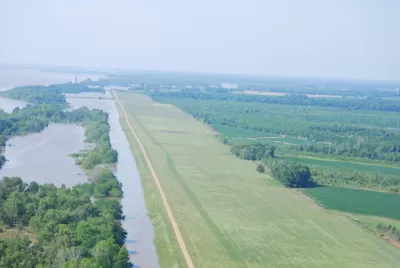Levees can save towns, but they can also push water downstream making floods worse, meaning that if wealthier places are protected, it’s sometimes at the expense of poor communities.

Where rivers flood, the most common technique used by the Army Corps of Engineers to protect homes is to build levees. Reporting from ProPublica suggest that this strategy creates some harm. When rivers don't overflow their banks, that water has to go somewhere, so levees that protect one area can worsen flooding in somewhere else. This makes the placement of levees a sticky issue.
The Army Corps of Engineers tries to prevent property damage so it looks at the value of land and homes near rivers and uses that information to help decide where to build levees. "But the calculations favor highly valued property over less affluent communities. And the Corps has favored levee-building over nonstructural fixes such as buying out homes to create space for the river to spread out during a flood — practices that many experts say are more effective in the long run, but which the Corps concluded were 'seldom economically justified,'" report Lisa Song, Patrick Michels, and Al Shaw for ProPublica. As climate change exacerbates extreme weather, flood infrastructure is going to become increasingly important.
FULL STORY: Flood Thy Neighbor: Who Stays Dry and Who Decides?

Study: Maui’s Plan to Convert Vacation Rentals to Long-Term Housing Could Cause Nearly $1 Billion Economic Loss
The plan would reduce visitor accommodation by 25,% resulting in 1,900 jobs lost.

North Texas Transit Leaders Tout Benefits of TOD for Growing Region
At a summit focused on transit-oriented development, policymakers discussed how North Texas’ expanded light rail system can serve as a tool for economic growth.

Why Should We Subsidize Public Transportation?
Many public transit agencies face financial stress due to rising costs, declining fare revenue, and declining subsidies. Transit advocates must provide a strong business case for increasing public transit funding.

How to Make US Trains Faster
Changes to boarding platforms and a switch to electric trains could improve U.S. passenger rail service without the added cost of high-speed rail.

Columbia’s Revitalized ‘Loop’ Is a Hub for Local Entrepreneurs
A focus on small businesses is helping a commercial corridor in Columbia, Missouri thrive.

Invasive Insect Threatens Minnesota’s Ash Forests
The Emerald Ash Borer is a rapidly spreading invasive pest threatening Minnesota’s ash trees, and homeowners are encouraged to plant diverse replacement species, avoid moving ash firewood, and monitor for signs of infestation.
Urban Design for Planners 1: Software Tools
This six-course series explores essential urban design concepts using open source software and equips planners with the tools they need to participate fully in the urban design process.
Planning for Universal Design
Learn the tools for implementing Universal Design in planning regulations.
City of Santa Clarita
Ascent Environmental
Institute for Housing and Urban Development Studies (IHS)
City of Grandview
Harvard GSD Executive Education
Toledo-Lucas County Plan Commissions
Salt Lake City
NYU Wagner Graduate School of Public Service


























